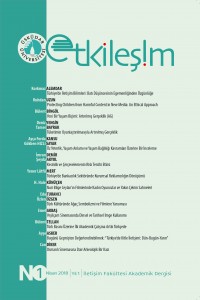Öz
Development and proliferation of new media have made ethical issues more complicated and multidimensional. The presence of children as users and content generators in new media has been the common source of concern regarding the possibilities of their exposure to harmful content and abuse. The new legislative regulations proposed quell this concern has brought a new concern regarding the possibility of the growth of government control over freedom of expression. In this study, it is suggested that ethical regulations must be discussed to minimize demands for legislative regulations that may restrict freedoms. Therefore, we try to detect the parties and their responsibilities in the development of proper content for the children in new media. Thus, this paper aims at contributing to the discussions on developing ethical principles and behavioral codes in accordance with specific characteristics of new media while producing content that consider the best interests of the child.
Anahtar Kelimeler
ethics new media child rights harmful content self-regulation
Kaynakça
- Belsey, A. and Chadwick, R. (eds) (2002). Ethical Issues in Journalism and The Media. Routledge.
- Chester, J. and Montgomery, K. (2008). “No Escape: Marketing To Kids in The Digital Age”. Multinational Monitor. 29(1). 11.
- Children’s Online Privacy Protection Rule. (1999). 16 C.F.R. § 312.2
- Eickhoff, C., Serdyukov, P., De Vries, A. P. (2011, February). “A Combined Topical/Non-Topical Approach to Identifying Web Sites for Children”. Proceedings of the Fourth ACM International Conference on Web Search and Data Mining. (505-514). ACM.
- EU Kids Online: Findings, Methods, Recommendations. http://eprints.lse.ac.uk/60512/.
- Friedman, S. J. (2000). Children and the World Wide Web: Tool or Trap. University Press of America.
- Hackley, C., Tiwsakul, R. A., Preuss, L. (2008). “An Ethical Evaluation of Product Placement: A Deceptive Practice?”. Business Ethics: A European Review. 17(2). 109-120.
- Hill, J. (2011). “Endangered Childhoods: How Consumerism Is Impacting Child And Youth Identity”. Media, Culture & Society 33(3). 347–362.
- Kunkel, D. et al. (2004). “Report of the APA Task Force on Advertising and Children, Section: Psychological Issues in the Increasing Commercialization of Childhood”.
- Livingstone, S. (2014). Regulating the Internet in the Interests of Children: Emerging European and International Approaches. http://eprints.lse.ac.uk/44962/.
- Lorenzana, J. A. (2002). “Addressing the Gaps in the Expanding Media Environment: A Report from the Philippines”. S. Kavitha (ed.) Kids On-Line: Promoting Responsible Use and A Safe Environment on the Net in Asia.Singapore: Stamford Press te. Ltd. 124-53.
- Lwin, M. O. Stanaland, A. J. S. Myazaki A. D. (2008). “Protecting Children’s Privacy Online: How Parental Mediation Strategies Affect Website Safeguard Effectiveness”. Journal of Retailing. 84(2). 205-217.
- McManis, L. D. and Gunnewig, S. B. (2012). “Finding the Education in Educational Technology with Early Learners”. YC Young Children. 67(3). 14.
- Montgomery, K. C. (2000). “Youth and Digital Media: A Policy Research Agenda”. Journal of Adolescent Health. 27(61).8.
- Montgomery, K. C. Chester, J. Grier, S. A., Dorfman, L. (2012). “The New Threat of Digital Marketing”. Pediatric Clinics of North America. 59(3). 659-675.
- Murray, M. and Kliman, M. (1999). “Beyond Point and Click: The Search for Gender Equity in Computer Games”. ENC Focus. 6(3). 23-27.
- Nairn, A. and Dew, A. (2007). “Pop-Ups, Pop-Unders, Banners and Buttons: The Ethics of Online Advertising to Primary School Children”. Journal of Direct, Data and Digital Marketing Practice. 9. 30-46.
- O’Neill, B. (2010). “Media Literacy and Communication Rights: Ethical Individualism in the New Media Environment”. The International Communication Gazette. 72(4-5). 323–338.
- Silverstone, R. (2004). “Regulation, Media Literacy and Media Civics”. Media, Culture and Society. 26(3). 440–9. Simmons, C. (2007). “Protecting Children While Silencing Them: The Children’s Online Privacy Protection Act and Children’s Free Speech Rights”. Communication Law and Policy. 12(2). 119-142.
- Sutter, G. (2000). “Nothing New Under the Sun: Old Fears and New Media”International Journal of Law and Information Technology. 8(3). Oxford University Press.
- Timisi, N. (2011). “Medyada Çocukları Koruyucu Önlemler”. M. R. Şirin (haz.) Çocuk Hakları ve Medya. (141-160). İstanbul: Çocuk Vakfı Yayınları.
- Turow, J. (2001). “Family Boundaries, Commercialism, and the Internet: A Framework for Research”. Applied Developmental Psychology. 22. 73–86.
- Uzun, R. (2014). “Çocukların Medyadan ve Medyada Korunması: Çocuklara Yönelik Etik Davranış Kurallarının İncelenmesi”. Akdeniz İletişim. 22.
- Walker, C. (1996). “Fundamental Rights, Fair Trials and the New Audio-Visual Sector”. MLR 59(4) 517-539.
- Wartella, E. A. and Jennings, N. (2000). “Children and Computers: New Technology-Old Concerns”. Children and Computer Technology. 10(2).
- Xu, H., Irani, N., Zhu, S., Xu, W. (2008). “Alleviating Parental Concerns for Children’s Online Privacy: A Value Sensitive Design Investigation”. ICIS 2008 Proceedings. 106.
Ayrıntılar
| Birincil Dil | İngilizce |
|---|---|
| Konular | İletişim ve Medya Çalışmaları |
| Bölüm | Makaleler |
| Yazarlar | |
| Yayımlanma Tarihi | 2 Nisan 2018 |
| Yayımlandığı Sayı | Yıl 2018 Sayı: 1 |
Kaynak Göster



 Bu eser Creative Commons Atıf-GayriTicari-Türetilemez 4.0 Uluslararası Lisansı ile lisanslanmıştır.
Bu eser Creative Commons Atıf-GayriTicari-Türetilemez 4.0 Uluslararası Lisansı ile lisanslanmıştır.


